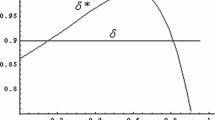Abstract
This paper explores the impact of debt holdings on the output decisions of firms in an oligopoly supergame with stochastic demand fluctuations. It is demonstrated that when perfect collusion is not feasible then there exist circumstances in which increased debt holdings may facilitate tacit collusion. This occurs because higher debt levels act as a credible commitment device which lowers the payoffs accruing to a firm when it defects from the tacitly collusive equilibrium. It is further shown that in these circumstances firms may have an incentive to hold debt for strategic purposes which promote collusion.
Similar content being viewed by others
References
Abreu, D. (1986): “Extremal Equilibria of Oligopolistic Supergames.”Journal of Economic Theory 39: 191–225.
Benoit, J. P., and Krishna, V. (1986): “Finitely Repeated Games.”Econometrica 53: 905–922.
Brander, J. A., and Lewis, T. R. (1986): “Oligopoly and Financial Structure: the Limited Liability Effect.”American Economic Review 76: 956–970.
— (1988): “Bankruptcy Costs and the Theory of Oligopoly.”Canadian Journal of Economics 21: 221–243.
Chevalier, J. A. (1995): “Capital Structure and Product Market Competition: Empirical Evidence from the Supermarket Industry.”American Economic Review 85: 415–435.
Chevalier, J. A., and Scharfstein, D. (1996): “Capital Market Imperfections and Countercyclical Markups: Theory and Evidence.”American Economic Review 86: 703–724.
De Angelo, H. and De Angelo, L. (1995): “Dividend Policy and Financial Distress: an Empirical Investigation of Troubled NYSE Firms.”Journal of Finance 45: 1415–1432.
Friedman, J. (1977):Oligopoly and the Theory of Games. Amsterdam: North-Holland.
Gibbons, R. (1992):A Primer in Game Theory. Hertfordshire: Harvester Wheatsheaf.
Gilson, S. (1997): “Transactions Costs and Capital Structure Choice: Evidence from Financially Distressed Firms.”Journal of Finance 50: 161–196.
Kesteloot, K., and Veugelers, R. (1995): “Stable R&D Cooperation with Spillovers.”Journal of Economics and Management Strategy 4: 651–672.
Kovenock, D., and Phillips, G. (1995): “Capital Structure and Product Market Rivalry: How Do We Reconcile Theory and Evidence.”American Economic Review 85: 403–408.
Maksimovic, V. (1988): “Capital Structure in Repeated Oligopolies.”Rand Journal of Economics 3: 389–407.
Phillips, G. (1995): “Increased Debt and Industry Product Markets: an Empirical Analysis.”Journal of Financial Economics 37: 189–238.
Shapiro, K. (1990): “Theories of Oligopoly Behavior.” InHandbook of Industrial Organisation, vol. 1, edited by R. Schmalensee and R. Willig. Amsterdam: North-Holland.
Staiger, R. W., and Wolak, F. A. (1992): “Collusive Pricing with Capacity Constraints in the Presence of Demand Uncertainty.”Rand Journal of Economics 23: 203–220.
Tirole, J. (1990):The Theory of Industrial Organisation. Cambridge, MA: MIT Press.
Author information
Authors and Affiliations
Rights and permissions
About this article
Cite this article
Damania, D. Debt as a collusive device in an oligopoly supergame. Journal of Economics Zeitschrift für Nationalökonomie 66, 249–269 (1997). https://doi.org/10.1007/BF01226828
Received:
Revised:
Issue Date:
DOI: https://doi.org/10.1007/BF01226828




